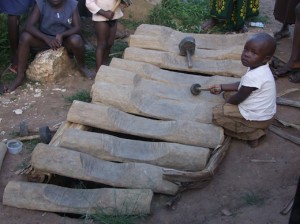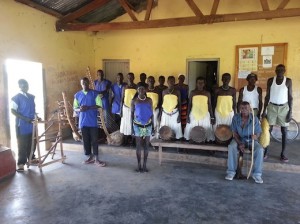After Patrick Ondiek and Steve Kivutia, went on a recce around Northern Uganda in September to help us put together an itinerary, I endeavored to discover a little more about the music we’d be discovering.
Gulu:
First we will discover the music of the Acholi tribe in Agago, where a variety of different styles of music are performed, each with there own different purposes. Click here to learn about the Acholi People.
1. We will hopefully see a performance of the Bwola, a traditional royal dance, performed in a circle, where the men drum around the outside and women dance in the middle without drums (typically in Uganda, drums are only for men). A group of elderly men would perform it during the time of crowning the chief and then when he dies. It is also performed to entertain important personnel on big occasions. Being the only royal dance, it is one of the most important of the many dances of the Acholi:
2. We then plan to record a group performing the Otole war dance, although as times are changing it can now function for entertainment. It is performed to train the male youths during tribal protection and instils courage in the men when going to fight and during actual tribal conflict that occurred according to Acholi history.
3. The next style we will record is the Larakarak courtship dance in Pawili. This is one for the youth, and, lucky for us, is usually performed in the dry months of December and January. When the young people in a particular village are ready for marriage, they organize a big ceremony where all potential partners meet. As a sign of friendship, food and alcoholic drinks are served during this ceremony. Only the best dancers will get partners, so there is a lot of competition during the dancing. Now it is performed during weddings and learnt at school:
4. We will then record a group performing the Dingidingi, usually performed by the young girls of the Acholi, and their movements are meant to imitate birds. The girls dance to attract the young boys, so the dance is usually held on bright days, when the sun is out.
In all of these dances we are likely to record the Adungu instrument (a traditional Ugandan bow-harp) and the Agwara (a wooden trumpet).
Pakwach and Nebbi:
Next we visit the Alur and Lugbara tribes in Nyaravuru and Pakwach.
Click here to learn more about these tribes through our Alur Profile and Lugbara Profile on the Singing Wells website.
Here we will record the Adungu and Agwara but also the Ndara, one of the traditional giant Ugandan xylophones, however this type are unique as they’re mounted over a large pit dug out in the ground:
1. Alur Kingdom Troupe – these are our first musical performers, who have traveled and performed in various East Africa Cities, are state champions and take part in a variety of state functions. Here they are playing the Agwara and performing the Agwara dance which is for a Kings coronation and praise.
The Alur tribe are part of the Luo people of Uganda, and they migrated to Uganda from Southern Sudan with other Luo peoples along the Nile banks.
2. Next we stay in Murchison Lodge in Pakwach and meet up with ‘The Aynu Traditional Music’ group, (a Lugbara group) ‘Wenipac and ‘Ndara Troupe‘ who will spend a day with us at the Lodge. These groups represent all of the Alur, Lugbara, Acholi, Kakwa, Madi and Kebu tribes! This seems to demonstrate how traditional music has created a sense of unity between many different tribes in one area.
These tribes are grouped tightly together in the North, as shown on the map below, and situated in an area that has previously been a war zone. This might have meant that their tribal differences became obsolete. Certainly, in the documentary ‘War Dance’ by Sean Fine and Andrea Nix in 2007, people in the North dealt with the scars of the recent attacks by the Lord Resistance Army thorugh playing and making music together. This transcends any past tension between tribal groups. In parallel, music is a fantastic way of holding on to tribal identity, as many villages were evacuated and millions were moved into displacement camps. Being away from home, the traditional music of one’s tribe and ancestors becomes much more important for recovery and a way of holding on to normality.
(The Tribal Structure of Uganda)
Lira:
We will then visit Lira and listen to the music of the Langi tribe. Go here to learn more about The Langi.
Unfortunately Steve and Patrick were told that the music in Lira is in decline and finding groups might be difficult. Part of our quest is to encourage the playing and sharing of local music. Luciky we have managed to arrange to see the Lango Cultural Group and the Deno Cultural Group whilst on a visit. They are also likely to play using the Adungu, and also the Ngwara Gwata (a hollowed out calabash). The musical styles are likely to be:
“Kiri” a war dance – where the women dance wielding knives and the men carry spears.
“Myele” a style which is performed when celebrating the birth of twins.
Soroti:
In Soroti we will record the music of the Iteso tribe.
The Iteso people speak ‘Ateso’ and are from the Teso region.
Traditionally, they play the Akogo (a thumb piano). Here is a clip of someone from the Teso region playing one:
Kampala:
In Kampala we will hear the music of a variety of styles and from different tribes in Uganda, being the capital city. We know we will visit the Adungu Cultural Troupe however, on the right is an image of one of the players using an Adungu which is a  traditional bow harp, taken when Steve and Patrick saw them during the recce for the trip. Below is an image of the Ndere Troupe, who represent the music of the Alur, Acholi, Ateso, Langi, Lugbara, Karamojong and the Batwa (all tribes from the Northern Nilotic and Luo parts of Uganda), who all managed to travel south to their capital and perform traditional music together.
traditional bow harp, taken when Steve and Patrick saw them during the recce for the trip. Below is an image of the Ndere Troupe, who represent the music of the Alur, Acholi, Ateso, Langi, Lugbara, Karamojong and the Batwa (all tribes from the Northern Nilotic and Luo parts of Uganda), who all managed to travel south to their capital and perform traditional music together.
We will then fly back to Nairobi and visit Ketebul music, where we can work on our Influence Series. Read more about that here.
Watch out for our Field Report of the trip and we will keep updating the Singing Wells website with news and information!





